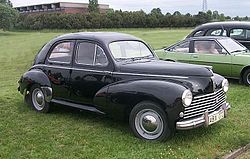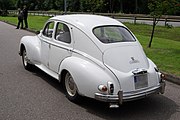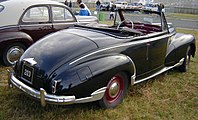Peugeot 203
| Peugeot | |
|---|---|
|
Peugeot 203 sedan (1948-1960)
|
|
| 203 | |
| Production period: | 1948-1960 |
| Class : | Lower middle class |
| Body versions : | Sedan , convertible sedan , station wagon , coupe , convertible , vans |
| Engines: |
Petrol engines : 1.3 liters (33 kW) |
| Length: | 4350-4530 mm |
| Width: | 1620 mm |
| Height: | 1560 mm |
| Wheelbase : | 2580-2780 mm |
| Empty weight : | 950 kg |
| successor | Peugeot 204 |
The Peugeot 203 was built in over 685,000 copies by the French car manufacturer Peugeot in Sochaux between October 1948 and February 1960 . It was the first new vehicle model developed by Peugeot after the Second World War . From 1949 to 1954 it was the brand's only model.
technology
The 203 was not a resumed pre-war model, but was completely redesigned. Initially, the smaller and weaker Peugeot 202 , developed in the 1930s, was offered in parallel. The 203 had a self-supporting body , hydraulically operated brakes and a front independent wheel suspension with a transverse leaf spring and rack and pinion steering . The rigid rear axle had coil springs and was guided by a drawbar and a Panhard rod . The model was powered by a four-cylinder engine with a capacity of 1290 cm³, the V-shaped hanging valves of which were controlled by an overhead camshaft via bumpers and rocker arms. The engine developed 33 kW (45 hp). The power was transmitted to the worm drive of the differential on the rear axle with a four-speed gearbox (fully synchronized from 1954) via a cardan shaft . Like many cars of the time, this vehicle also had a steering wheel gearshift . The electrical system worked with a voltage of twelve volts, which was provided by two six-volt batteries connected in series . As an extra, the limousines could be equipped with a sliding roof . The model was modified again and again to improve driving behavior and comfort. The construction of the chassis and engine were slightly modified and still used in the Peugeot 403 .
variants
Were offered in addition to the sedan a Decouvrable (convertible saloon), a coupe, a convertible and various combi versions , called Familial , Commerciale , Fourgonnette , Fourgon , Camionnette and more. At times, there were up to twelve different body versions with different wheelbases and bodies to choose from. The 203 was also exported, particularly to the then French colonial areas of Africa and Asia.
The French coachbuilder Emile Darl'mat converted around 250 vehicles. He reduced the height of the car by 140 mm and increased the compression ratio to 7.4: 1. This gave the engine 50 hp and a permanent top speed of 140 km / h was achieved. There were also 1.5 liter engines with 70 horsepower. In 1951, the tuner also built a plastic body for the 203 and, from 1952, a coupé variant with an aluminum body.
Under the name Peugeot VSP , Peugeot also developed an off-road vehicle based on the 203, which, however, met with little interest from the military. One of the prototypes was later in the plant fire brigade of Peugeot as a fire engine used.
Model development
The shape of the 203 was changed only slightly during the production period. Only a few minor modifications reveal the year of construction.
10/1948: Start of production. The offer consists of a limousine and a decouvrable.
10/1949: Seats without chrome trim, omission of the toggle handle on the trunk. Introduction of station wagons, pickups and delivery vans.
05/1950: Elimination of the decorative decoration on the front fenders
10/1950: Bumper horns on the right and left of the front license plate
04/1951: Bumpers completely chrome-plated and new license plate
lights 10/1951: Sales start for the convertible
01/1952: dashboard painted in the vehicle color
03 / 1952: new bumpers
10/1952: deflectors on the front doors, semicircular speedometer, enlarged taillights. Introduction of the coupé.
10/1953: Renewed tank cap, profiled bumpers that extend further around the body. The water drains on the roof now follow the shape of the doors instead of reaching to the trunk. Discontinuation of the 203 Coupé.
09/1954: reclining seats, change of license plate
lighting 08/1956: indicators instead of indicators. Setting of the Découvrable and the Cabriolet.
04/1957: slightly enlarged hubcaps
09/1958: elimination of the lion on the bonnet for reasons of passive safety
02/1960: end of production.
review
“At a press conference of the French Peugeot works recently, the new series passenger car 'Peugeot 203' was shown, the construction of which has elegant American lines. The elegant and comfortable car is a five-seater and only weighs 880 kilograms. Its powerful four cylinders develop a top speed of 118 kilometers per hour with 42 hp. According to the current conditions, the new car has been designed as a petrol saver and only needs eight to nine liters of petrol for 100 kilometers. The new Peugeot is to ration card within a month to 28,000 S available. "
“It was only on the occasion of the last Paris Motor Show in October 1948 that [the Peugeot factory] went public with its first post-war creation, the Peugeot 203 . All preparations have now been made to bring out 300 pieces per day, but whether this plan is actually feasible depends only on the steel allocation by the government. The new Peugeot is not much larger than the 202 model, but it is considerably more powerful , as can be seen from the whole construction. Since the four-cylinder (speed 4000 rpm) has a bore of 75 mm and a stroke of 73 mm, the cylinder space has an almost square cross-section, and the relatively short stroke has the advantage that the piston speed can be kept lower. The displacement is 1290 ccm, the power 42 HP. The cams have been given a new, patented shape that guarantees that the machine runs quietly by avoiding high valve accelerations. [...] The candles are arranged in the middle of the hemispherical combustion chamber, which is an essential prerequisite for knock-free operation. The fuel consumption is given as 7.5 to 9 liters for 100 km with an hourly average of 70 to 85 h / km (maximum speed 115 h / km). The acceleration is good due to the favorable gear ratios. The first three gears are helically toothed and synchronized, the fourth gear is used as an overdrive. The transmission is operated by shifting the steering wheel. "
literature
- Walter draftsman: Peugeot 203/403/404 1948-72. A documentation. Stuttgart 1987, ISBN 3-922617-18-2
Individual evidence
- ↑ zerotrois.ch
- ↑ Archived copy ( memento of the original from January 6, 2014 in the Internet Archive ) Info: The archive link was inserted automatically and has not yet been checked. Please check the original and archive link according to the instructions and then remove this notice.
- ↑ A top product in the French auto industry. In: Das kleine Volksblatt , January 18, 1949, p. 6 (online at ANNO ).
- ↑ "Peugeot 203" now also in Vienna. In: New Austria / New Austria. Organ of Democratic Unification , January 23, 1949, p. 5 (online at ANNO ).
Web links
- zerotrois.ch Private website with information about the Peugeot 203
| Timeline of the Peugeot models since 1945 | ||||||||||||||||||||||||||||||||||||||||||||||||||||||||||||||||||||||||||||
|---|---|---|---|---|---|---|---|---|---|---|---|---|---|---|---|---|---|---|---|---|---|---|---|---|---|---|---|---|---|---|---|---|---|---|---|---|---|---|---|---|---|---|---|---|---|---|---|---|---|---|---|---|---|---|---|---|---|---|---|---|---|---|---|---|---|---|---|---|---|---|---|---|---|---|---|---|
| Type | 40s | 50s | 60s | 70s | 80s | 90s | 2000s | 2010s | 2020s | |||||||||||||||||||||||||||||||||||||||||||||||||||||||||||||||||||
| 5 | 6th | 7th | 8th | 9 | 0 | 1 | 2 | 3 | 4th | 5 | 6th | 7th | 8th | 9 | 0 | 1 | 2 | 3 | 4th | 5 | 6th | 7th | 8th | 9 | 0 | 1 | 2 | 3 | 4th | 5 | 6th | 7th | 8th | 9 | 0 | 1 | 2 | 3 | 4th | 5 | 6th | 7th | 8th | 9 | 0 | 1 | 2 | 3 | 4th | 5 | 6th | 7th | 8th | 9 | 0 | 1 | 2 | 3 | 4th | 5 | 6th | 7th | 8th | 9 | 0 | 1 | 2 | 3 | 4th | 5 | 6th | 7th | 8th | 9 | 0 | |
| Microcar | ion | |||||||||||||||||||||||||||||||||||||||||||||||||||||||||||||||||||||||||||
| 106 | 107 | 108 | ||||||||||||||||||||||||||||||||||||||||||||||||||||||||||||||||||||||||||
| Small car | 104 | 205 | 206 | |||||||||||||||||||||||||||||||||||||||||||||||||||||||||||||||||||||||||
| 202 | 207 | 208 I. | 208 II | |||||||||||||||||||||||||||||||||||||||||||||||||||||||||||||||||||||||||
| Compact class | 204 | 301 | ||||||||||||||||||||||||||||||||||||||||||||||||||||||||||||||||||||||||||
| 203 | 304 | 305 | 306 | 307 | 308 I. | 308 II | ||||||||||||||||||||||||||||||||||||||||||||||||||||||||||||||||||||||
| Lower middle class | 309 | 408 I. | 408 II | |||||||||||||||||||||||||||||||||||||||||||||||||||||||||||||||||||||||||
| Middle class | 403 | 404 | 405 | 406 | 407 | |||||||||||||||||||||||||||||||||||||||||||||||||||||||||||||||||||||||
| 505 | 508 I. | 508 II | ||||||||||||||||||||||||||||||||||||||||||||||||||||||||||||||||||||||||||
| upper middle class | 504 | |||||||||||||||||||||||||||||||||||||||||||||||||||||||||||||||||||||||||||
| 604 | 605 | 607 | ||||||||||||||||||||||||||||||||||||||||||||||||||||||||||||||||||||||||||
| Coupe | RCZ | |||||||||||||||||||||||||||||||||||||||||||||||||||||||||||||||||||||||||||
| 404 coupe | 504 coupe | 406 coupe | 407 coupe | |||||||||||||||||||||||||||||||||||||||||||||||||||||||||||||||||||||||||
| Minivan | 1007 | |||||||||||||||||||||||||||||||||||||||||||||||||||||||||||||||||||||||||||
| Crossover | 2008 I. | 2008 II | ||||||||||||||||||||||||||||||||||||||||||||||||||||||||||||||||||||||||||
| 3008 I. | ||||||||||||||||||||||||||||||||||||||||||||||||||||||||||||||||||||||||||||
| SUV | 3008 II | |||||||||||||||||||||||||||||||||||||||||||||||||||||||||||||||||||||||||||
| 4008 | ||||||||||||||||||||||||||||||||||||||||||||||||||||||||||||||||||||||||||||
| 4007 | ||||||||||||||||||||||||||||||||||||||||||||||||||||||||||||||||||||||||||||
| 5008 II | ||||||||||||||||||||||||||||||||||||||||||||||||||||||||||||||||||||||||||||
| Compact van | 5008 I. | |||||||||||||||||||||||||||||||||||||||||||||||||||||||||||||||||||||||||||
| Van | 806 | 807 | ||||||||||||||||||||||||||||||||||||||||||||||||||||||||||||||||||||||||||
| Off-road vehicle | P4 | |||||||||||||||||||||||||||||||||||||||||||||||||||||||||||||||||||||||||||
| Pick up | 403 truck | 404 pick up | 504 pick up | Pick up | Land trek | |||||||||||||||||||||||||||||||||||||||||||||||||||||||||||||||||||||||
| High roof combination | Traveler | |||||||||||||||||||||||||||||||||||||||||||||||||||||||||||||||||||||||||||
| Box van | 205 Multi / Fourgonnette | |||||||||||||||||||||||||||||||||||||||||||||||||||||||||||||||||||||||||||
| Bipper | ||||||||||||||||||||||||||||||||||||||||||||||||||||||||||||||||||||||||||||
| partner | partner | Rifter | ||||||||||||||||||||||||||||||||||||||||||||||||||||||||||||||||||||||||||
| Transporter | D3 | D4 | J7 | J9 | Expert | Expert | Expert | |||||||||||||||||||||||||||||||||||||||||||||||||||||||||||||||||||||
| J5 | boxer | boxer | ||||||||||||||||||||||||||||||||||||||||||||||||||||||||||||||||||||||||||
|
|
||||||||||||||||||||||||||||||||||||||||||||||||||||||||||||||||||||||||||||
| Timeline of the Peugeot models from 1889 to 1944 | ||||||||||||||||||||||||||||||||||||||||||||||||||||||||
|---|---|---|---|---|---|---|---|---|---|---|---|---|---|---|---|---|---|---|---|---|---|---|---|---|---|---|---|---|---|---|---|---|---|---|---|---|---|---|---|---|---|---|---|---|---|---|---|---|---|---|---|---|---|---|---|---|
| Type | 1880s | 1890s | 1900s | 1910s | 1920s | 1930s | 1940s | |||||||||||||||||||||||||||||||||||||||||||||||||
| 9 | 0 | 1 | 2 | 3 | 4th | 5 | 6th | 7th | 8th | 9 | 0 | 1 | 2 | 3 | 4th | 5 | 6th | 7th | 8th | 9 | 0 | 1 | 2 | 3 | 4th | 5 | 6th | 7th | 8th | 9 | 0 | 1 | 2 | 3 | 4th | 5 | 6th | 7th | 8th | 9 | 0 | 1 | 2 | 3 | 4th | 5 | 6th | 7th | 8th | 9 | 0 | 1 | 2 | 3 | 4th | |
| Small car | 1 | 2 | 3 / 4 | 5 / 6 / 7 / 8 | 21 / 24 / 30 / 31 | 37 | 54 | 57 | 69 "Bébé" | B P1 / B3 / P1 "Bébé" [1] | 161/172 "Quadrilette" | 190 | ||||||||||||||||||||||||||||||||||||||||||||
| 26 / 27 / 28 | 48 | 126 | 201 | 202 ... | ||||||||||||||||||||||||||||||||||||||||||||||||||||
| Compact class | 14 / 15 / 25 | 56 | 58 | 68 | VA / VC / VY [1] | V2C / V2Y [1] | VD / VD2 [1] | 159 | 163/163 BS | 301 | 302 | |||||||||||||||||||||||||||||||||||||||||||||
| 33 / 36 | 63 | 99 | 108 | 118 | 125 | 173 / 177 / 181 / 183 | ||||||||||||||||||||||||||||||||||||||||||||||||||
| Middle class | 9 / 10 / 11 / 12 | 16 / 17 / 19 / 32 | 49/50 | 65/67 | 77 | 78 | 88 | 127 | 143 | 153 | 153 B / BR | 176 | 401 | 402 | ||||||||||||||||||||||||||||||||||||||||||
| 18th | 39 | 61 | 71 | 81 | 96 | 106 | 116 | 126 | 138 | 175 | ||||||||||||||||||||||||||||||||||||||||||||||
| upper middle class | 23 | 42/43/44 | 62 | 72 | 82 | 92 | 104 | 112/117/122/130/134 | 139 | 145/146/148 | 174 / 184 | 601 | ||||||||||||||||||||||||||||||||||||||||||||
| 66 | 76 | 83 | 93 | 135 | 156 | |||||||||||||||||||||||||||||||||||||||||||||||||||
| Upper class | 80 | 103 | 113 | 141 | 147/150 | |||||||||||||||||||||||||||||||||||||||||||||||||||
| 85 | 95 | 105 | ||||||||||||||||||||||||||||||||||||||||||||||||||||||
| Convertible / Spider | 91 | 101/120 | 133 / 111/129/131 | 136 | 144 | |||||||||||||||||||||||||||||||||||||||||||||||||||
| Box van | 13 | 22nd | 34/35 | |||||||||||||||||||||||||||||||||||||||||||||||||||||
| minibus | 20 / 29 | 107 | ||||||||||||||||||||||||||||||||||||||||||||||||||||||





